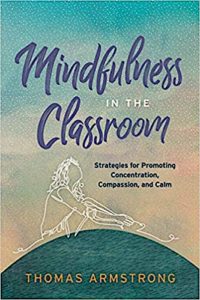Strategies to Bring Mindfulness into Class
Mindfulness in the Classroom: Strategies for Promoting Concentration, Compassion, and Calm
By Thomas Armstrong
(ASCD, 2019 – Learn more)

Mindfulness is more than an educational buzzword. Author and education researcher Thomas Armstrong defines the much-talked-about strategy as “the intentional focus of one’s attention on the present moment in a nonjudgmental way.”
Using research-based evidence and studies, this book provides insight into the significant positive impact of mindfulness on cognitive and emotional functioning, as well as its ability to relieve stress.

Armstrong frequently calls upon the work of biologist Jon Kabat-Zinn – founder of the Stress Reduction Clinic at the University of Massachusetts Medical Center – throughout this book. Kabat-Zinn has taken what was once considered a religious practice “…rooted in a thousand-year-old Buddhist tradition” and has given mindfulness “a solid secular foundation in science.” (p.8)
Armstrong quotes various studies describing the positive effects of mindfulness in treating chronic pain, immune function, anxiety, depression, and stress disorders (to name a few). Along with providing research, he offers “Teacher and Student Testimonials for Mindfulness,” providing more evidence of the benefit of creating a positive mindset in students.
For example, he notes that “Taking a few minutes for quiet meditation at the beginning of each class serves as a transition for students to get into a different mindset for learning the logic of math.” (Dunn School, 2018) (p.13)
We expect our students to take in a lot of information from each subject area, and mindful practices help the brain relax, open up, and create focus. Mindfulness practice is not an additional program, Armstrong says, but aligns seamlessly with current programs, as he shows in one of the many resources provided in the book, “How Mindfulness Aligns with Existing Education Initiatives and Programs.” (p.17)
Understanding the brain and stress
Chapter Two provides insight into the brain and how it is affected by stress, even in our youngest students. The impact stress plays on teachers’ and students’ thought patterns and emotions can become physically exhausting. A stressed-out teacher who is on the verge of burnout can unintentionally pass along their stress to students who are already having feelings of anxiety due to academic pressures and outside environmental factors.
A regular mindfulness practice can help de-stress the brain, a finding Armstrong further delves into as he shares neuroscience research suggesting that mindfulness “alters the stress-producing pathways of the brain in three different ways” – leading him into an exploration of the Prefrontal Cortex.
Armstrong then offers “Understanding the Basics,” which includes “The Simple Magic of Breathing” focusing on the “physical sensations of breathing,” “The rise and fall of the belly,” “Counting each breath from 1 to 10” – all to create focus.
“The important thing is that our breath is the core event of this practice to which we’re always returning whenever we get distracted.” (p.32) To help us bring this into real classrooms, Armstrong provides a “Mindful Breathing” framework to use with students on page 33.
Formal and informal mindfulness
Dr. Armstrong then turns our attention to “Formal Versus Informal Mindfulness Practices” (pages 36-40), defining formal practices as “those experiences that are deliberate, time limited, and have a specific focus.” (p.36) Formal practices include mindful breathing, mindful walking, mindful eating, and mindful stretching. Armstrong also includes The “Body Scan” practice developed as part of the Mindfulness Based Stress Reduction program “spearheaded by Jon Kabat-Zinn (2013)” (p.38).
Informal practices are “instances in which mindfulness is practiced in the midst of normal life experience: washing the dishes, cleaning the house (or classroom), showering, playing a sport, doing art, reading, completing a written assignment, riding a bike, driving a car or nearly any other activity.” (p.40)
In a section titled “Practicing Self-Care as a Teacher,” he explains “the high cost of teacher stress,” examining the great deal of stress teachers are put under, leading to lack of engagement, lack of connecting emotionally with students, and lack of initiative to put energy into their teaching duties. “A stressed-out teacher is not an effective teacher.” (p.47)
He includes a “Teacher Burnout Checklist” to help determine if stress is a problem. Armstrong notes “a positive response to a single item may indicate that it is.” (p.47) He modifies a well-known proverb to read “Educator, heal thyself” as a way of emphasizing the importance of teachers learning self-care strategies that include mindfulness practices. (p.49)
Compassionate mindfulness
Armstrong addresses “Teaching Kindness and Compassion,” which includes “The Benefits of Being Mindfully Compassionate.” “As students develop their ability to focus, they also build their capacity to sustain universal, non-referential love and compassion. At the same time, feeling kindness and love for others helps an individual develop a peace of mind that is useful for entering into a focused state.” (p.59)
Several resources, including “A Curriculum of Kindness,” “Projects That Encourage Kindness” and “Tips for Integrating Kindness into the Classroom,” offer steps and ways to carve time into the classroom for discussions that allow students to express their thoughts and feelings.
Armstrong also looks at the importance of adapting to students’ developmental stages. Elementary level is seen as “a broader tool kit of social and emotional learning strategies,” middle school includes “metacognition,” and high school is where “the emphasis is placed on the practice… [including] use [of] technology related mindfulness apps.” (p.81)
How the First Amendment affects public school practices
Chapter nine’s topic is crucial. “Respecting the First Amendment” discusses the importance of not having spiritual or religious overtones when using mindfulness in a public school. “The situation is clear – mindfulness as it should be (and usually is) taught in public schools is entirely secular and grounded not in religion, but in science.” (p.109) Armstrong includes a chart, “Do’s and Don’ts for Teaching Mindfulness in U.S. Public Schools.” Rounding out this chapter is a section entitled “Clearing Up a Few Misconceptions” with some clarifying statements about what mindfulness practice is and isn’t.
Each chapter transitions to the next by offering important “Takeaways.” There are two appendices included. Appendix A offers a glossary of neuroscience terms that I found extremely helpful in my understanding of the brain. Appendix B provides “Resources for Mindfulness Education” with apps, audio guides, and many resources such as books for children and educators, as well as training programs for educators and students. Finally, Armstrong provides an extensive list of references for further reading on any of the studies, programs, articles and websites mentioned in the book.
I’ve begun incorporating the practice of mindfulness into my classroom this year, and I found Mindfulness in the Classroom to be of great interest. I would highly recommend this book to any educator looking to expand their knowledge of mindfulness or ready to take steps to implement this practice into their classroom.
Kathleen Palmieri is a fifth grade teacher in upstate New York who reviews regularly for MiddleWeb. With a passion for literacy and learning in the classroom, she participates in various writing workshops and curriculum writing endeavors. As a lifelong learner, she is an avid reader and researcher of educational practices and techniques. Collaborating with colleagues and globally on Twitter @Kathie042500 is an ongoing practice.

































